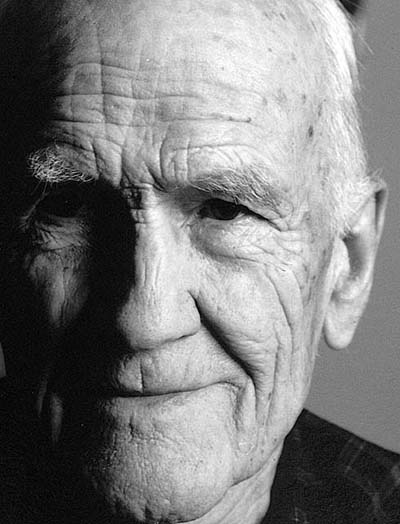
Henry Bradford ?Brad? Washburn, 1910?2007. [Photo] Giulio Malfer
The great and venerable Bradford Washburn, icon of Alaskan mountaineering, photographic and cartographic pioneer, scientist, writer, pilot, and mentor and friend to countless climbers, has passed. He was 96.
Born in 1910 in Cambridge, Massachusetts, Washburn was part of the Harvard Five, a historic group of lifelong friends that included Charlie Houston, H. Adams Carter, Terry Moore and Bob Bates. The five came into North American climbing in its infancy, and their skills as mountaineers, together with their grace and refined manners, helped define its expectations and standards. Their achievements took place before a time of professionalism; without the funding available to today’s alpinists, they climbed as a hobby and pursued careers that rounded out their characters. In the end, they influenced their peers, their proteges and their well-wishers as much by how they comported themselves throughout their lives–first and foremost as gentlemen–as they did with their prodigious accomplishments in mountaineering.
And none more so than Washburn. From his beginnings in New Hampshire’s Presidential Range, Washburn learned the craft under the tutelage of masters such as Armand Charlet, and quickly distinguished himself even among his guides with his proclivity. In 1929, he was elected to the French Alpine Club’s prestigious Groupe de Haute Montagne in recognition of his Alpine accomplishments.
In 1927, he published one of his first books, Among the Alps with Bradford; it would be followed by many others, including 1991’s Mt. McKinley: The Conquest of Denali, and by countless magazine and journal articles. After graduating from Harvard University in 1933, Washburn began pioneering routes in Alaska, and in particular in the Alaska Range, a collection of magnificent peaks that would imprint itself upon him. His photo library and encyclopedic knowledge of the range would assist generations of climbers in their aspirations; it would also allow him to debunk Frederick Cook’s claim to have made the first ascent of Denali, a cause that Washburn followed closely all of his life.
Washburn was named Director of the New England Museum of Natural History (now the Boston Museum of Science) in 1938, when he was 29; he married Barbara Polk two years later and quickly introduced her to mountaineering (during their honeymoon they made the first ascent of Mt. Bertha in Alaska’s Fairweather Range–Barbara’s first climb). In 1947 they climbed the Muldrow Glacier Route together; Barbara’s summit was the first female ascent of the peak (it was Bradford’s second time on top; the first had come via the same route five years earlier). In 1951 Bradford established the quintessential North American mountaineering route, Denali’s West Buttress, a line that remains one of the classics of world climbing.
Washburn returned to the range long after he concluded his climbing career, often to capture the grandeur and drama of North America’s most magnificent peaks with a scientist’s precision. In an obituary published January 11 on the Boston Globe’s website, Michael J. Bailey and Andrew Ryan wrote, “In photography, Mr. Washburn married [a] profound sense of purpose with a sense of wonder. For his aerial images, he devised an elaborate process to capture the light and the detail, the drama and the sweep of what he experienced. He would yank the side door off a single-engine plane and strap himself and his 53-pound Fairchild K-6 camera into position at the opening. At more than 20,000 feet with buffeting winds, well below zero temperatures, a vibrating and yawing fuselage, and oxygen supped through a bottle, conditions were brutal.
“The results were striking. Because they were shot from adjacent or diagonal angles, rather than from straight above or from the base, the shrouded rocks and shifting clouds create visceral, almost animate images. Epic in scale yet intimate in detail and shadings, they are more like portraits of individual mountains than landscapes.”
Washburn’s maps of the Grand Canyon, the Alaska Range, the Presidential Range and Mt. Everest remain the finest of their kind, a status underscored by his 1979 reception of the Royal Scottish Geographical Society’s Gold Medal for “outstanding contributions to cartographic research.” He was no stranger to such accolades; in 1988, he became the recipient, with Barbara, of the Centennial Medal from the National Geographic Society “for a lifetime of exploration, discovery and cartography.” In 1994, he received the King Albert Medal of Merit from the Belgium’s King Albert Foundation in recognition of “his guiding spirit in the ambitious and successful enterprise of making a new large-scale map of the roof of the world from 1982 to 1991.” His contributions in the world of climbing continued to the end: in 1999, he coordinated the scientific survey of Mt. Everest that resulted in a revised altitude of 8850 meters, and his images of the Alaska Range continue to inspire climbers who seek to attempt new routes or to ascend the classics that he established.
In the spring of 2004, in Alpinist Magazine, Washburn penned the following lines:
“I started climbing in the Alps, in Chamonix, when I was sixteen years old. It was so different back then–we didn’t have the telepheriques, [there weren’t] the people [there are] today. [But] to me it was never about just the climbing itself. It was the camping, the group of friends you were with. That’s what was important to us.
“I’m a photographer who climbs, not a climber who photographs. I started out taking pictures of friends in Chamonix. I enjoyed getting good shots, but I had more fun taking pictures of mountains. I’ve had a pretty good record of taking a picture of something that hasn’t been climbed, [indicating] the route that I would do and watching it get climbed right away. That has always made me feel great. My legacy won’t be climbing–I haven’t climbed since 1953–but hopefully it will be in seeing the possibilities for others.”
Washburn helped climbers see possibilities that without his assistance would have remained unknown. He was a noble and unforgettable man whose influence will be felt for generations.